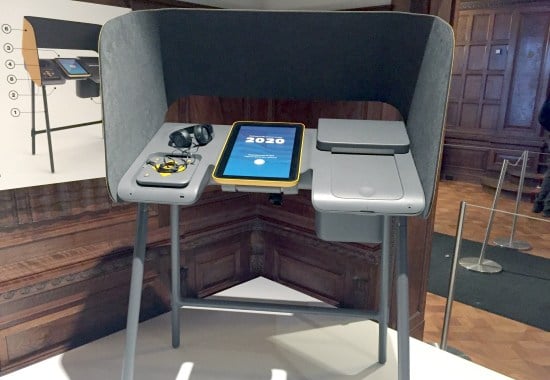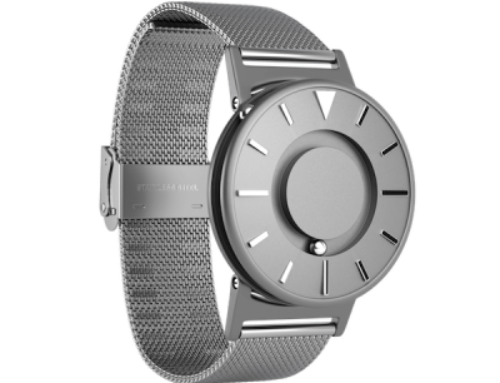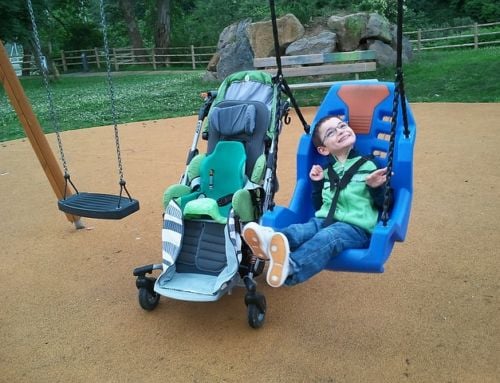Far from AT–an Interview with Documentary Film Star Leah Smith

Andrew Solomon’s celebrated book–Far from the Tree: Parents, Children and the Search for Identity–is now a movie! Recently, AT3 Center News and Tips had the unique opportunity to interview Leah Smith, a featured parent, about her tools and broader insights for parenting with dwarfism and parenting in general.

Leah Smith, Joe Stramondo, and baby Hazel
Last September, AT3 Center News and Tips posted an article about an accessible crib written by Christina Mills, Deputy Director of Ability Tools, the state Assistive Technology (AT) Program for California. It quickly accrued the most number of shares of anything we’d published to date [until this post!]
That experience and the emergence of an Oklahoma ABLE Tech project that specifically serves parents with disabilities led us to pursue more content on the topic of adapted baby equipment and assistive technology (AT) for parenting more broadly. To our delight, those inquiries soon landed us with Leah Smith, new mom to Silas (age 2 months) and Hazel (age 2 years).
Leah has been rocketing to a certain amount of fame following the release of Far From the Tree, the documentary directed by the Emmy Award winner, Rachel Dretzin. Leah and her husband, Joe, have different forms of dwarfism and Joe uses a wheelchair. They are among four families profiled in the documentary, released this summer for nationwide distribution, based on Andrew Solomon’s book of the same title.
The book and movie explore the issue of how parents respond to raising children who are different in some way from themselves–who are, in effect, apples who fell “far from the tree.” In the book, children with dwarfism are some of these apples. In the movie, Leah and Joe become parents of average-height children and invert the book’s presumed paradigm; Silas and Hazel, who have no known disabilities, are now far from the tree.
We spoke with Leah this month about her experience becoming a mom and the adaptations and equipment she and Joe have found useful thus far on their parenting journey. Not surprisingly, our conversation often veered far from AT. The drift began with the first question…
AT3 Center: How did you get ready for parenting?
Leah Smith: Well, we were very open to either adoption or having kids [ourselves] but we started with adoption. We both grew up attending LPA, Little People of America, which has a very positive adoption culture and we felt we had a strong responsibility to the adoption route. So when you go through the adoption process, you really have to flesh out your beliefs about parenting. What would we do? How would we deal with this? What is it that we want? We did a lot of thinking.
And what ended up happening was we went through two failed adoptions and then we were broke [laughing]. I say failed adoptions, but we were basically just ambassadors to these new parents for what it looks like to have dwarf children. Because, essentially, [the birth moms] were giving up their children because they have dwarfism.
AT3: So you were intending to adopt children with dwarfism? And in the process, the parents met you and changed their minds?
LS: Yes. And I remember there being this moment with the first average-height birth mom. She said, “So you guys seem so… happy… And you’re… doing great.” And it was this moment where I wanted to say to her, “No! We’re not doing good at all” [laughing]. Because, of course, we wanted to adopt! But for her, she clearly realized, “Oh! I could do this. These are people. And I’m having a person!”
So I got off that call and said to Joe, “We just lost that child.”
And we were sad, but it was a really great outcome for Mom and baby, I think. And we went through two of those.
AT3: Clearly there’s a whole need out there for just getting to know people like you and Joe…
LS: Yes, and that’s one of the reasons we decided to do the movie. We thought, there’s a need for this! But no one should have to go through the heartache of adoption, on both sides, it’s a really hard process. It’s just not needed. And so we realized we could do this another way. The movie actually followed us through one of the failed adoptions, but they didn’t have room to include it. (Now you have an exclusive!)
AT3: So then you got pregnant?
LS: We waited a few months and then got pregnant with Hazel and immediately we were like how do we do this? We have different access needs. How do we make this accessible for both of us? And one thing we did was find Christina Mills’s crib on Craig’s list.
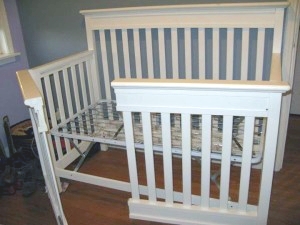
Christina Mills’s crib
AT3: Wait. The same crib? The one we posted?
LS: A similar design. It was interesting, we bought it from a mom who doesn’t have a disability but she’d used it as a transition bed for her toddler. It’s a case of universal design. At the point the kid is ready to climb up and over, they can just open the gate! It worked that way for Hazel too. She exited through the gate.
Something else we did was cut a changing table in half [and adapted it] for two different heights. Because Joe needs a lower height than I do. That has worked really well.

Both halves of their divided changing table. The right side was originally a shelf. The mirror mounted on the wall entertains baby Silas.
Also, we attached an infant booster seat to wheels, to a dolly. Joe uses it to carry babies from room to room. It’s like a super-low stroller.

Silas, a wee bit resentful of the photo op
My sister has twins and gave us her special breastfeeding pillow that’s very firm and has been hugely accessible for us. Silas can lay straight on that without being held which is a big help.
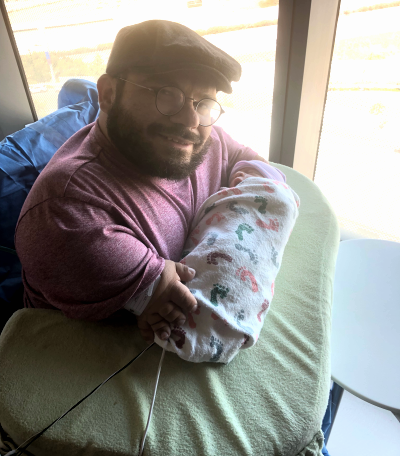
Joe with Silas on the breastfeeding pillow originally designed to support twins.
It’s hard for me to think of everything I use because I don’t know what other people use. I just do what I do.
AT3: Were there any things you worried about before having Hazel that turned out to not be a problem?
LS: Hmm. Well, I think half of parenting is worry! But I think, definitely, having average size children, I had a fear of when Hazel got to be two, picking her up. Some of those things are obviously much harder for us, but that fear has actually turned out to be pretty unnecessary. It’s amazing. I find when it’s just us, out in public or wherever, she’s very communicative and I think by us not picking her up and not just swooping her off, she has developed this whole new level in her that a lot of kids probably don’t have.
I think it has allowed her to be a better person. But then again [laughing] she’s my kid! I’ve noticed that when her grandma or her auties are around they’ll just swoop in and pick her up and she’s like Oh! What’s this? And they’re like, See? That’s all she needed. And I’m like No… she’s amazed at the oddity of it. She’s in awe. She didn’t stop crying because you solved the problem!
I do think that as she gets older that will only work in her favor, this emotional intelligence. And one of my parenting choices is to try to help her become emotionally intelligent, but still be able to express her feelings and not silence her and all those important things (after all, she is only two!)
AT3: And of course, there’s more to physical contact than just being scooped off the ground. Still, you’re talking about a certain kind of necessary resiliency. Then again, any child whose parent has another baby is going to get scooped less because there’s often another kid in that arm already…
LS: I think what’s been amazing to me is that it’s really just a relationship, and like any other relationship it’s about building trust and her knowing that I do care and love her and those are the important things. I think in our society we have that as being picked up and held. But it’s not the same thing. Hazel is very loved and she knows that. She also knows that she can come to me at any time. We were at the zoo the other day and she had a huge meltdown and she just came over and we sat on the sidewalk and hugged. She just needed to be held for a minute. She didn’t need to be carried around.
AT3: Are there challenges that took you by surprise related to your disability?
LS: I think figuring it out at each stage. For Joe, every stage he’s had to figure out how to make it accessible for him to parent and interact. Christina Mills was a huge influence in our lives.
AT3: You know Christina!

Christina Mills
LS: Yes and when Hazel was just learning to walk we noticed Christina’s son was riding on her wheelchair like it was nothing. And I asked her, “At what age did you know he was safe on your wheelchair?”
She said, “What do you mean?”
I said, “At what age did you know he would hold on?”
And she was like, “You haven’t put Hazel on his chair yet?! Oh my gosh! Put her on there! NOW.”
I was like, “Really?”
“Yes! Once she’s sitting up, you’re good. Set her there and she’ll hold on.”
So literally that day we put Hazel on and she was right. She held on and now she has like four different positions for sitting on Joe’s chair with him. But it was this crossing-over stage, and needing another disabled parent to say, Just dive in! She said we’d hear so many comments, and we have (some positive and some negative).

Joe and Hazel
AT3: This really begs deep questions about human development. At this, the most over-protective moment in human history! Because, really, it’s just cultural…
LS: I met a woman who spent $1,500 baby-proofing her home. And privately, I thought, my house would scare the you-know-what out of her. We have a regular kitchen and then we have a kitchen for Joe and he does like 60% of the cooking. He has everything about two feet off the floor. We have a stove; we have a microwave and toaster. It’s been there since Hazel was born. We’ve taught her what’s not safe and she knows. We say, “Hey Hazel! That’s hot! Don’t touch!” And she’s not once had a problem. I think as a society we have this idea that children are a lot less competent than they are. I always hesitate to tell this story. But we’ll see what Silas is like…
AT3: And if need be, you’ll make a change.
LS: Also, my kitchen is average height and I use stools everywhere. It’s been amazing to watch Hazel adapt to them. My approach has been you can climb, but let’s do it safely. So she’s learned much earlier than other kids. Her daycare was like, Did you know she can move a stool to get something? And I was, Oh yeah. She’s been seeing me do that forever. So she started at a year old.
AT3: It suggests Hazel may be getting wired up to problem-solve! Could be an advantage.
LS: I think so, but then again, she’s my kid! I’m hopeful.
AT3: What kind of resources are needed that don’t exist?
LS: We would love a stroller that attaches to Joe’s wheelchair. There’s only a prototype so far [also this prototype soon to be marketed]. More strollers for wheelchairs of different types that can serve different purposes so that they’re universally designed and affordable. More strollers low enough to see over. And more discussions just like this! There are so few conversations, and so people don’t know or don’t try.
Leah Smith is a media and entertainment advocate for the Center for Disability Rights. Joe Stramondo is an assistant professor of philosophy at San Diego State University. Resources they recommend:
The Disabled Parenting Project
LP Pregnancy Facebook Group
LP New Mom Facebook Group
Monthly Blog Digest
Search the blog
State AT Program Blogs
California
Florida
Indiana
Kentucky
Louisiana
Maryland
Massachusetts
Michigan
Montana
North Carolina
North Dakota
Utah
State AT Program Blogs
The AT3 Center, the Association of AT Act Programs (ATAP), and the Administration on Community Living (ACL) make no endorsement, representation, or warranty expressed or implied for any product, device, or information set forth in this blog. The AT3 Center, ATAP, and ACL have not examined, reviewed, or tested any product or device hereto referred.

